
Rodeo is a competitive equestrian sport that arose out of the working practices of cattle herding in Spain and Mexico, expanding throughout the Americas and to other nations. It was originally based on the skills required of the working vaqueros and later, cowboys, in what today is the western United States, western Canada, and northern Mexico. Today, it is a sporting event that involves horses and other livestock, designed to test the skill and speed of the cowboys and cowgirls. American-style professional rodeos generally comprise the following events: tie-down roping, team roping, steer wrestling, Steer roping, saddle bronc riding, bareback bronc riding, bull riding and barrel racing. The events are divided into two basic categories: the rough stock events and the timed events. Depending on sanctioning organization and region, other events such as breakaway roping, goat tying, and pole bending may also be a part of some rodeos. The "world's first public cowboy contest" was held on July 4, 1883, in Pecos, Texas, between cattle driver Trav Windham and roper Morg Livingston.

The festival of San Fermín is a week-long, historically rooted celebration held annually in the city of Pamplona, Navarre, Spain. The celebrations start at noon on 6 July and continue until midnight on 14 July. A firework (Chupinazo) starts off the celebrations and the popular song Pobre de mí is sung at the end. The most famous event is the running of the bulls, which begins at 8 a.m. each day on 7–14 July, but the festival involves many other traditional and folkloric events. It is known locally as Sanfermines in Spanish and Sanferminak in Basque, and is held in honour of Saint Fermin, the co-patron of Navarre.

A running of the bulls is an event that involves running in front of a small group of bulls, typically six but sometimes ten or more, that have been let loose on sectioned-off streets in a town, usually as part of a summertime festival. Particular breeds of cattle may be favored, such as the toro bravo in Spain, also often used in post-run bullfighting, and Camargue cattle in Occitan France, which are not fought. Bulls are typically used in such events.

Fermin was a legendary holy man and martyr, traditionally venerated as the co-patron saint of Navarre, Spain. His death may be associated with either the Decian persecution (250) or Diocletianic Persecution (303).

Goat cheese, goat's cheese or chèvre is cheese made from goat's milk. Goats were among the first animals to be domesticated for producing food. Goat cheese is made around the world with a variety of recipes, giving many different styles of cheeses, from fresh and soft to aged and hard.

Vincent of Saragossa, the Protomartyr of Spain, was a deacon of the Church of Saragossa. He is the patron saint of Lisbon and Valencia. His feast day is 22 January in the Catholic Church and Anglican Communion and the Orthodox Church, with an additional commemoration on 11 November in the Orthodox Church. He was born at Huesca and martyred under the Emperor Diocletian around the year 304.

Benavente is a town and municipality in the north of the province of Zamora, in the autonomous community Castile and León of Spain. It has about 20,000 inhabitants.

A blood sport or bloodsport is a category of sport or entertainment that involves bloodshed. Common examples of the former include combat sports such as cockfighting and dog fighting, and some forms of hunting and fishing. Activities characterized as blood sports, but involving only human participants, include the ancient Roman gladiatorial games.
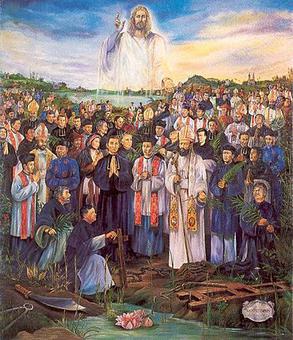
Vietnamese Martyrs or Saint Andrew Dung-Lac and Companions, also known as the Martyrs of Annam, Martyrs of Tonkin and Cochinchina, Martyrs of Indochina, are saints on the General Roman Calendar who were canonized by Pope John Paul II. On June 19, 1988, thousands of Overseas Vietnamese worldwide gathered at the Vatican for the Celebration of the Canonization of 117 Vietnamese Martyrs, an event chaired by Monsignor Trần Văn Hoài. Their memorial is on November 24.
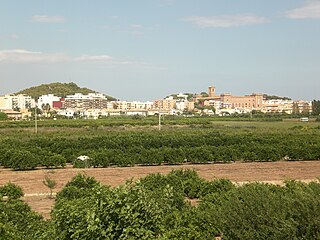
El Puig, officially El Puig de Santa Maria since 2012, is a village situated 15 km north of the city of Valencia in the comarca of Horta Nord, Spain. Its name means "hill" in Valencian). The municipality comprises three main areas, the first being the village itself, which is dominated by a monastery, and two large wooded hills next to it, the largest of which has the ruins of a castle fortress at the top. Originally, however, there was another hill named La Pedrera which disappeared gradually during the 20th century to make way for the V-21 motorway, with the rock being used to construct one of the jetties at Valencia's port. The second section is the coastal area of 4 km of beach with eight housing developments that are generally only inhabited in the summer; and finally, there is an industrial park located between them.
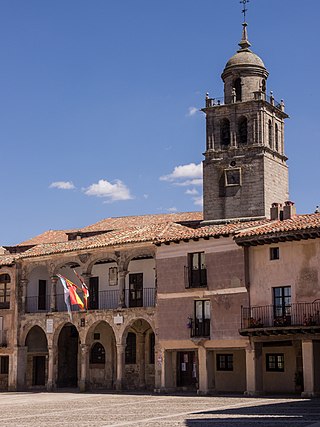
Medinaceli is a municipality and town in the province of Soria, in Castile and León, Spain. The municipality includes other villages like Torralba del Moral.

Navas de San Juan is a Spanish village of the province of province of Jaén, Spain. According to the 2005 census (INE), the city has a population of 5,030 inhabitants. It is the biggest village in the region of El Condado. The river called Guadalimar runs for its municipal area.

Oliete is a municipality located in the province of Teruel, Aragon, Spain. According to the 2017 census (INE), the municipality has a population of 357 inhabitants.

Manganeses de la Polvorosa is a municipality located in the province of Zamora, Castile and León, Spain. According to the 2022 census (INE), the municipality has a population of 623 inhabitants.
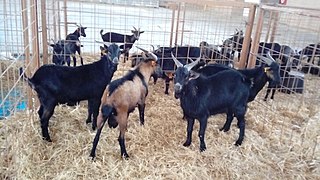
The Verata is a traditional Spanish breed of domestic goat. It is a dual-purpose breed, reared both for its meat and for its milk. It is named for, and is thought to originate in, the comarca of La Vera, in the province of Cáceres, in the northern part of the autonomous community of Extremadura in western central Spain. It is one of two traditional goat breeds in Extremadura, the other being the Retinta Extremeña.

Alexander Rupert Fiske-Harrison is an English author, journalist and conservationist.
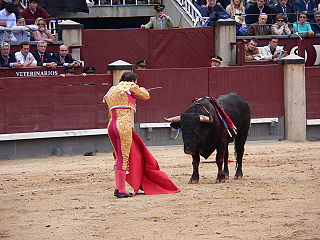
Bullfighting is a physical contest that involves a bullfighter attempting to subdue, immobilize, or kill a bull, usually according to a set of rules, guidelines, or cultural expectations.

March 12 - Eastern Orthodox liturgical calendar - March 14

The Toro de la Vega is a Spanish medieval bull festival and tournament celebrated in the town of Tordesillas in Valladolid, Spain. The tournament consists of hundreds of lancers chasing – either by foot or on horseback – a bull through town streets, corralling it into an open area. Once the bull has been drawn out away from town, it is killed by spearing. The tournament follows a series of strict rules and procedures dating back to the mid 16th century.
Animal welfare and rights in Spain is about the treatment of and laws concerning non-human animals in Spain. Spain has moderate animal protections by international standards.



















